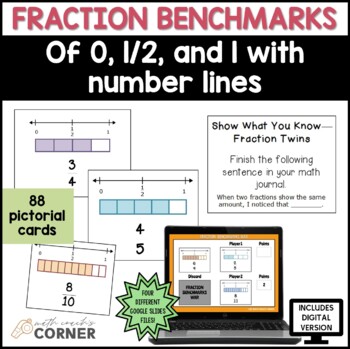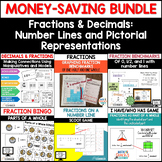Fractions on a Number Line | Fraction Benchmarks | Games using Pictorial Cards

What educators are saying
Also included in
- This bundle contains 6 resources for teaching fractions and decimals. With number lines or other pictorial representations in all the products, they're great for building deep understanding. The bundle price is like getting one product FREE!!BE SURE TO VIEW THE PREVIEWS OF ALL OF THE RESOURCES!WHATPrice $22.60Original Price $28.25Save $5.65
Description
You'll find a TON of uses for these pictorial cards showing fractions on a number line with benchmarks of 0, 1/2, and 1. Includes instructions for games focusing on benchmarks, comparing fractions, and equivalent fractions designed to help students develop "fraction sense" and reason about the size of fractions. Perfect for math centers!
INCLUDES
☀️ 88 pictorial fraction cards (denominators from 2 to 12) showing fractions on a number line along with benchmarks and an area model to make connections
☀️ Instructions included for 3 games:
- Card Sort (develop benchmarks)
- War (comparing fractions)
- Fraction Twins (equivalent fractions)
☀️ Math talk cards to add accountability to your centers and promote student reflection
☀️ 4 different Google Slides files! One file with slides for all 88 picture cards and a file for each of the activities listed above.
DOWNLOAD THE PREVIEW FOR TEACHING NOTES AND DESCRIPTIONS OF ALL THE ACTIVITIES!
⏩⏩⏩⏩ Be sure to Leave a Review in "Your Purchases" on your dashboard to earn free credits good toward the purchase of future products!
YOU MIGHT ALSO LIKE…
✅ Comparing Fractions Using Strategies Games Bundle
✅ Equivalent Fraction Puzzles | PRINT AND DIGITAL
✅ Decimals & Fractions: Making Connections with Manipulatives and Models
CONNECT WITH MATH COACH'S CORNER
Be sure to follow my TpT store by clicking on ‘Follow Me’ next to my Seller picture to receive notifications of new products and upcoming sales. Visit my blog for K-5 math tips and freebies you can use tomorrow in your classroom. You can also find me on Facebook and Twitter.
TERMS OF USE
Copyright © Math Coach's Corner.
For personal and single-classroom use only.
To share this resource with friends or colleagues, please purchase additional licenses.






